The Syrian regime’s allies held on to the term “Syria’s sovereignty” no less than the regime’s own institutions, its official media and its leading figures. They all issued repeated demands with regards to respecting the territorial unity of the “Syrian Arab Republic” as a politically and geographically unified state, terms that held center stage at international and regional meetings.
The term “sovereignty” once again appeared in protestations by Russia, Iran and the Lebanese Hezbollah against the recent US strike in April. These countries have also protested against the repeated targeting by Israel of the outskirts of Damascus at a time when these same countries are using Syria as the setting for their own air and land operations and, by doing so, violating the real meaning of “sovereignty”.
The emphasis on the unity of Syrian territories and the avoidance of creating conditions on the ground that cannot be changed were among the demands put forward by the delegation of opposition factions at the fourth Astana round. However, the actual situation on the ground has witnessed the destruction of sovereignty since 2012, with the regime hiring allied militias that have been – and remain – its most prominent forces, standing alongside it in all battles.
In this report, Enab Baladi presents the distribution of power between the various forces in Syria, the locations of international and regional intervention through military bases or land forces. It draws on the views of political and military figures regarding Syrian sovereignty and seeks to analyze possible directions in the country’s future in light of the rapid developments on the ground.
Southern Syria is heading towards “decentralization”
As international intervention in Syria has increased, all northern and southern areas have fallen outside the control of the regime in Damascus, whose “limited” sovereignty is restricted to major cities on the coast and in the central region as well as the capital.
Western and Arab countries, most notably the United States, the United Kingdom, Russia, Turkey, Jordan and Israel, share military influence in the north and south, whether on the ground or through air and missile dominance, as well as through supporting armed factions that emerged in light of the security and administrative vacuum left by the regime.
This area includes the provinces of Daraa, Quneitra and al-Suwayda up to the Syrian Badia. Despite the relatively limited presence of the Syrian regime in the three provinces, it has no effective control in light of the dominance of regional powers and states in the areas bordering the Golan Heights occupied by Israel.
Large areas of the provinces of Daraa and Quneitra are under the control of opposition factions that are supported by the Military Operations Coordination (MOC), which consists of Western and Arab countries, most notably the United States, the United Kingdom, the United Arab Emirates and Jordan.
However, Syria’s southern neighbor, Jordan, exerts the greatest security and intelligence influence through its strong ties with al-Jabha al-Janubiyya (the “Southern Front”) of the Free Army and through its infiltration within the border areas between the two countries. Today, Jordan is considering the establishment of an air base bordering Syrian territory in an attempt to intervene militarily against the Khalid bin al-Walid Army, which is accused of being associated with ISIS.
Al-Suwayda, which has a Druze majority, appears to be under the regime’s control but, in effect, it is being governed by people’s committees established by Druze clerics. The area recently witnessed clashes between the committees, al-Assad’s forces and security bodies, which may indicate that the province is completely outside the “sovereignty” of Damascus, and that it might even be part of the project of decentralized federal rule called for by opposition parties months ago, that did not include Quneitra and Daraa, which is supported by Israel.
The eastern countryside of al-Suwayda up to the al-Tanf border area with Jordan in the Syrian Badia has fallen under the control of the United States, the United Kingdom and Jordan. These countries support factions in the Free Army against ISIS, up to the region of al-Bukamal in Deir ez-Zor province, thus “eradicating” ISIS from the entire border area with Jordan.
Information from the ground indicates that these forces are planning to have a long-term presence in the region through the establishment of a military base run by British and US forces in al-Tanf, as well as talk in Jordan of the establishment of a nearby air base, as mentioned above.
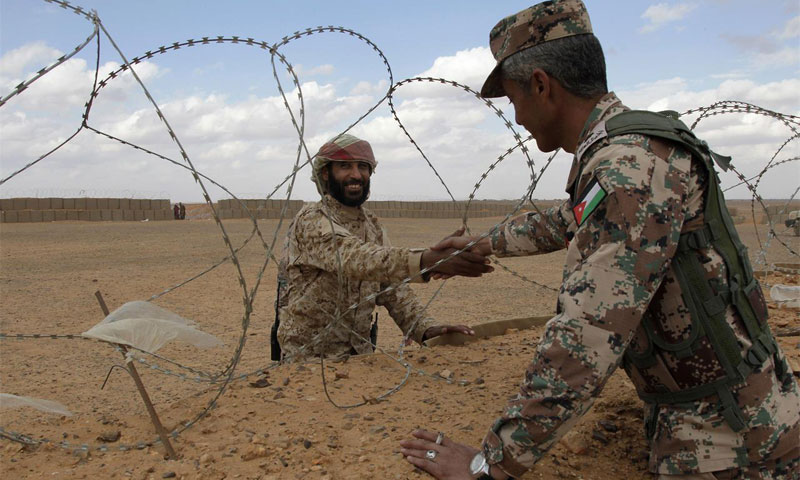
A Syrian soldier from the Army of Free Tribes shakes hands with a Jordanian soldier at the border at al-Rukban camp, 14 February 2017 (AP)
Complicated details in northern Syria
The Syrian north extends from north-east of al-Hasakah close to where the Syrian border intersects with Iraq and Turkey to north-west of Aleppo, next to Syria’s border with Ankara. This vast area, which is equivalent to about one-third of Syrian territory, contains no presence on the part of al-Assad’s forces apart from security and service institutions in al-Hasakah and al-Qamishli.
Starting from al-Hasakah province, through to the northern and western countryside of Raqqa, up to the areas of Ayn al-Arab (Kobanî) and Manbij in the eastern countryside of Aleppo, all these areas are under the control of the Syrian Democratic Forces, which are dominated by the Kurdish militia, the People’s Protection Units (in Kurdish, Yekîneyên Parastina Gel – YPG), backed from the ground and air by the US-led “International Alliance”.
Washington has established military and air bases in this area, especially in the area of Rmelan in the north of al-Hasakah, in the area of Kobanî in the eastern countryside of Aleppo, and in the area of Ayn Issa in the northern countryside of Raqqa. There is a possibility that France and the UK, which are part of the coalition, will establish bases similar to those of Washington.
That area is self-administered by the Kurdish Democratic Union Party, which declared it an autonomous “federal” region that is administratively affiliated to the Syrian state, in a prelude and support that might reflect the possibility of a future federal Syrian regime.
Turkey exerts political and military control over a region that extends from the southern borders of Manbij, passing Tripoli up to the city of Azaz in northern Aleppo, and, as of a few months ago, reaching the city of al-Bab after its ground and air intervention against ISIS as part of Operation Euphrates Shield, in which it supported the factions of the Free Army, to preempt the Syrian Democratic Forces’ move towards the city and take full control over northern Syria.
North-west of Aleppo, the area of Afrin is controlled by the Syrian Democratic Forces, up to the city of Tell Rifaat and the nearby town of Menagh in the northern countryside of Aleppo. This area has recently witnessed Russian influence that appears to be a preemptive step against possible Turkish military intervention. In addition, there is talk of a Russian military base being established in the area of Kafr Janneh in the countryside of Afrin.
Russian domination over Aleppo
Within days of al-Assad’s forces and its allied militias gaining control of the entire city of Aleppo with Russian support in December 2016, Moscow distributed its military forces inside the city under the name of the “Russian police”, in a move to “ensure security and stability” within the city.
The developments on the ground in Syria highlight the dominance of Russia over the details of daily and military life in Aleppo and the decline of al-Assad’s control in the city, as well as Moscow’s attempts to expel Iranian militias from the city.
This was explicitly stated by the Russian envoy to Astana, who said that talk of expelling forces belonging to Iran from Syria would be “possible after ensuring a stable truce”. Analysts interviewed by Enab Baladi predicted that “the Syrian regime might also be expelled when Russia would ensure that its interests will not be affected”.
Russian influence has penetrated into all aspects of Aleppo. It has distributed its own engineers to dismantle mines in the eastern neighborhoods, which were under the control of the opposition, and has begun to train members of al-Assad’s forces. In addition, it deployed humanitarian, medical and civilian officers, in the midst of an almost complete absence of al-Assad’s army and militias, which played a larger role in regaining control of the city.
Israel violates “sovereignty” and Iran expands
For the first time in recent decades, the Syrian regime responded to Israel’s frequent violation of Syria’s “sovereignty” by targeting a military base belonging to “the enemy” with long-range missiles last March. However, this came too late since, despite the fact that the regime confirmed that it brought down an Israeli aircraft and shot another, Tel Aviv denied this by asserting that its defenses “fought back the missiles and deactivated them”.
The Syrian regime’s response came in the context of Israel’s targeting of a weapons convoy that was heading towards the Lebanese Hezbollah. In addition, Israel has repeatedly targeted sites in the vicinity of the capital Damascus. The most recent one was carried out on Thursday morning, April 27, which al-Assad’s forces admitted, in an official statement, had caused “material losses”. However, Enab Baladi’s sources confirmed that, since 2013, the international airport in the east of the capital has fallen under the control of the Iranians and has also become the first destination for Iranian, Afghan, Pakistani and Iraqi militias of the Islamic Revolutionary Guard Corps (IRGC).
Religious shrines in the capital Damascus, especially in the southern Sayyidah Zaynab region, have been transformed, in the last two years, into a main base for Shiite visitors and militias, especially from Iran and Iraq. According to reports prepared by activists in the heart of the capital, these militias have taken over management of these shrines instead of the Syrian regime, which is supposed to exercise sovereignty in Syria.
The region has become a purely Iranian province. In addition, Tehran’s power increased in the western side of the capital after the opposition evacuated its locations there, starting with the displacement of citizens from the towns of western al-Qalamoun, then the citizens of Darayya in August 2016, reaching the areas of Qudsaya, al-Hamah, al-Tell, Wadi Barada and finally, this year, al-Zabadani and Madaya, which were part of a deal in which Iran was the main player.
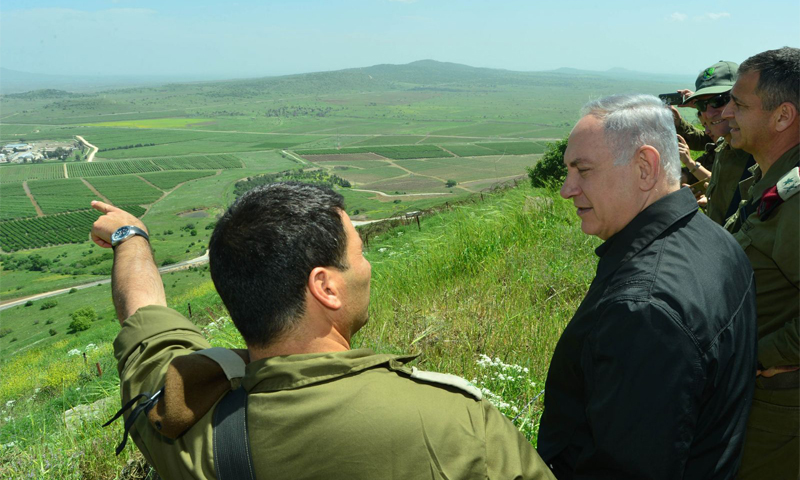
Israeli Prime Minister Benjamin Netanyahu examining the Syrian side of the Occupied Golan Heights with military leaders, April 2016 (Internet)
ISIS receding in the east
We move to the eastern side of Syria, in which the Syrian regime lost all its positions of “sovereignty” since the first year of the revolution. ISIS is still active in this region and, today, still controls Raqqa and its surrounding villages, while the Syrian Democratic Forces are trying to wrest control of these areas from ISIS, in the midst of an almost complete absence of al-Assad’s forces.
ISIS’s power is also evident in Aleppo’s eastern countryside, while large areas of Deir ez-Zor have been under its control since 2014, while the regime controls some neighborhoods, as well as the military airport, the mountains and the military zones surrounding it.
ISIS is seeking to expand its control in the region as a step to strengthen its key positions in case the Syrian Democratic Forces take control of Raqqa. In addition, ISIS has made attempts to advance further into the south of al-Hasakah, to appear as if it is in control of the eastern region of Syria.
Enab Baladi spoke to military analyst, Colonel Pilot Hatem al-Rawi, to discuss the future of the region. He said that ISIS’s moves are taking place simultaneously in the east of Syria and the western region of Iraq. He considers that the move is “heading towards Sunni regions in particular”.
ISIS is being pushed back in Mosul, which had been its biggest stronghold in Iraq. Al-Rawi pointed out that despite the weakness of the Syrian Democratic Forces, which are advancing further into the region with the support of the US, “They were able to impose negotiations on ISIS”. He expected that this would apply throughout the whole region in the coming days, “After the re-demarcation of borders in the area between Iraq and Syria, the eastern region will belong to its people and not to any other side”.
Iran and the regime were the first to breach “sovereignty”
According to al-Rawi, the country most responsible for penetrating entire regions – Lebanon, Iraq, Syria and Yemen – is Iran, “Since the arrival of Khomeini in 1979, who hijacked the Persian Spring and turned it into the rule of the “Faqih” (scholar), Iran has been living under the ideology of the gang, which can only survive in unstable areas, the latest of which is Syria.”
The Colonel Pilot said that, for years, Iran had been trying to enter Iraq but could not. It exploited the Lebanese conflict and founded Hezbollah as a base and violated Lebanon’s sovereignty. He pointed out that the absence of stability in Syria drew Tehran into the country. The regime contributed to the entry of Iran’s militias, in addition to foreign fighters, “It was the first side to violate the sovereignty of Syria. There is no longer an inch of Syria that has not seen the interference of foreign powers.”
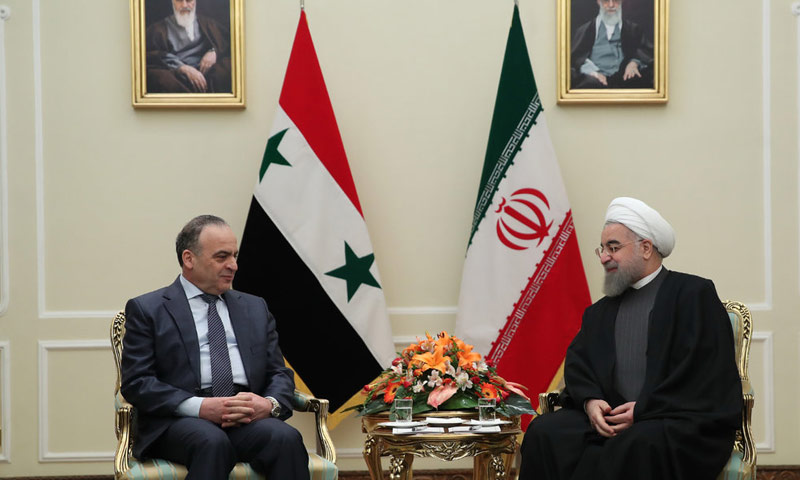
President of the Syrian regime government Imad Khamis and the Iranian President Hassan Rouhani (AFP)
“The regime would have been better off saying at the start of the revolution that Syria is a small country that everyone has the opportunity to toy with. This would have been more honorable and would have saved face”, according to al-Rawi, who considered that the regime “is still singing to the tune of national sovereignty but this is a mistake. What sovereignty are they talking about?”.
The military analyst did not overlook the Syrian Democratic Forces’ advancement in the east with American support, in addition to Turkey’s expansion into northern Syria. He pointed out that “Ankara’s interference, despite the fact that as revolutionaries we are pleased with that, does not eliminate the issue that it is a foreign force free to do what it wants in the north of Syria.”
Syria’s sovereignty and future in the eyes of the opposition
Enab Baladi talked to political and military opponents of the regime, who spoke about their views concerning sovereignty. Mohamed Sabra, chief opposition negotiator in Geneva, said, “The regime lost its legitimacy as a governing regime that expresses Syria’s sovereignty since the first shot it fired on the “martyr”, Mahmoud al-Jawabra, on March 18, 2011.”
Sabra considers that “shooting on demonstrators represents the very opposite of the role of the state, which is supposed to run the country and achieve the three general objectives of the state, which are security, peace and public health”. He argues that “Bashar al-Assad violated the security of citizens rather than protecting them. In addition, he destroyed the concept of ‘authority’ in its legal and practical sense when it brought in and armed sectarian militias.”
The opposition deals with al-Assad as the leader of a militia that has taken over a section of Syrian territory, as described by the political opposition activist, which is what made him lose any status as a representative of the Syrian state “after he destroyed it and turned it into a failed state, lacking the elements of sovereignty”. He sees the struggle of the Syrians as a struggle “for freedom and independence together, and the reconstruction of the national state, a state for all its citizens.”
All countries that have intervened in Syria have an interest in prolonging the conflict and making Syria a “fragmented and tasty bite” enabling them to make profits and expand their influence, according to Captain Saeed Nakrash, director of the Political Bureau and External Relations of Liwaa Shuhadaa al-Islam (Martyrs of Islam Brigade).
Nakrash says that these interventions could allow the forces to remain in Syria, “The Syrian regime, in exchange for its survival and continued support from Iran and Russia, has signed agreements guaranteeing the continued survival of the bases and influence of these countries.” He added that Tehran and Moscow “are working on establishing militias within what remains of the Syrian Army, while maintaining their loyalties to the two countries.”
The Director of the Political Bureau is of the view that there is huge competition between the Russians and Iranians, pointing out that “in light of the great conflict of interests between the two countries, we are still excluded from many secret agreements under which Bashar al-Assad sold Syria and its sovereignty and independence.”
Colonel al-Rawi concludes that Syria’s future is based on the fact that “federalism is better than partition”. In his view, “the decision-making countries in Syria have no interest in staying there. They establish bases, realize their interests and then turn their backs and move on. What is now happening in Iraq is the best example”.
The Iraqi government is discussing with the United States the possibility of establishing five bases under the management of the Iraqis and American consultants and experts. According to al-Rawi, “The strong parties in Syria will protect their interests in the same way. The weak parties, however (ISIS, al-Nusra Front, foreign fighters and militias), will not be able to continue because people cannot accept these foreign entities, which will leave, as was the case with many previous experiences”.
Colonel al-Tayar confirmed that Russia “will not leave taking a slice but not through the presence of permanent forces in Syria,” pointing out that “the US promised Russia to abide by all contracts that it signed with the regime. In fact, Putin works in Syria and asks the US to pay his salary”.
The interests of international and regional powers in Syria, which for years has become an arena for all, are tangled. According to al-Rawi, the country “may contain something similar to nominal federations but they are not as independent as the Kurdish proposal for autonomous administration”. He concludes that “Syria will return to the borders of Sykes-Picot someday”.
Foreign military bases that negate any “sovereignty”
Two US bases in Rmelan and Ayn al-Arab
The US established its first airbase in Syria southeast of Rmelan in al-Hasakah in November 2015, after turning Abu Hajar agricultural airport into a military airbase, using helicopters as a first step to coordinate its operations against the “Islamic State” in Syria and Iraq.
The United States equipped the airbase with technicians and expanded its stands to a height of 2,500 meters, according to observers.
The second airbase is located near Ayn al-Arab (Kobanî), 90 kilometers north of Raqqa, which is under the control of the “Islamic State”, and about 35 kilometers from the Turkish border.
It also includes military aircraft and a military logistics support center. US Admiral Carlton Everhart said last April that “the airbase will play an important role in transporting supplies, equipment and personnel,” according to Turkish media sources.
Al-Tanf base under British-Jordanian oversight
The base was established in May 2016 near the al-Tanf border crossing on the Jordanian-Iraqi border, under British, Jordanian and American oversight in the recent period. Western reports say that there is an intention to expand the base to serve as a launching pad for military operations against the “Islamic State” in southern and eastern Syria, aimed at expelling it from the Syrian Desert, and even Bu Kamal and Deir ez-Zor.
Military factions in the Free Army were trained inside the base, which is considered a joint operations room. The most prominent of these factions are Jaysh Maghawir al-Thawra, Jaysh Usud al-Sharqiya and the New Syrian Army.
The Russian “Khmeimim” air base in Latakia
The airbase is one of the most prominent Russian bases in Syria and is located 23 kilometers south of the city of Latakia, about five kilometers from the city of Jableh and about 14 kilometers from al-Qardaha. It became a location for Russian soldiers since September 2015 with the beginning of the Russian intervention.
The base contains Russian air defense systems, helicopters and warplanes, which Russia has used mainly in the recent military operations in support of the al-Assad regime in Aleppo, countryside of Idlib, Homs, Hama and countryside of Damascus. It has the task of military coordination and operations monitoring between all parties in Syria.
Undeclared Turkish airbases North and East of Aleppo
After the Turkish military intervention in Syria through Operation Euphrates Shield in August 2016, Turkey established military airbases in the northern and eastern countryside of Aleppo but it has not officially declared their existence.
According to separate sources in the Free Syrian Army who made identical claims in interviews with Enab Baladi, the first airbase was set up in the town of Dabiq in the north and was reserved for individuals only, without the presence of any heavy military equipment.
The second airbase is located in the town of Akhtarin and includes heavy artillery and military equipment. Ankara targets sites held by the Syrian Democratic Forces in Tell Rifaat and Menagh and surrounding villages.
The Turkish Forces also established an airbase in Jabal al-Shaykh Aqeel overlooking the city of al-Bab after its opposition factions gained control of it earlier this year. The base contains heavy artillery and military equipment, according to sources.
A Base for warships in Tartus
The base was established by Russia in 1971 as a naval base limited to logistical support and the supply of ships. After 2011, the naval base witnessed significant activity, which later increased with the announcement of Moscow’s military intervention in support of the regime.
The Syrian regime signed an agreement with Moscow in January of this year to expand the base after granting it rights to use it for 49 years. In addition to expanding the financial and technical supply center for the Russian military fleet, the regime allowed the presence of around 11 warships in the port at the same time.
The Political Economy of the Syrian Crisis
Soqrat al-Ilou
 One country’s crisis is usually another country’s investment opportunity. The saying “states are not charities” is a golden rule in international relations, on which any realistic analysis should be based, to explain the reasons behind a country’s involvement in another country’s crisis. As for the narratives used to legitimize intervention, they are merely a cultural, humanitarian or ideological cover to legitimize murder and war.
One country’s crisis is usually another country’s investment opportunity. The saying “states are not charities” is a golden rule in international relations, on which any realistic analysis should be based, to explain the reasons behind a country’s involvement in another country’s crisis. As for the narratives used to legitimize intervention, they are merely a cultural, humanitarian or ideological cover to legitimize murder and war.
In the Syrian case, it is necessary to broaden the political viewpoint to include the geographical and economic dimensions. This allows us to have a geopolitical approach, which provides a basis for analyzing the interlocking and conflicting interests of the parties directly involved in the conflict.
It can be said that Syria is the “victim of geography”, which has put it at the heart of three regional schemes fighting over the role of the “central state” in the Middle East in an effort to fill the American vacuum in the region – the Iranian, Turkish and Israeli strategies.
The Iranian strategy, which Bashar al-Assad chose to join forces with, represents a national project with a sectarian cover that tries to impose Persian hegemony on the Middle East, exploiting the Shiite doctrine in order to expand within the Arab region.
The importance of Syria for this project is not only limited to political borders, but goes beyond that to the geographical and economic dimensions. The first is the importance of Syria’s location as a passageway for Iran to the Mediterranean on the one hand, and one of the routes for terrestrial communications links of the Iranian axis in the region (Iran, Iraq, Syria, Lebanon).
The second dimension focuses on means of exporting energy. Iran is the second largest gas producer in the world but its geographical location forces it to export through two compulsory passages – either by sea or by land. The sea route goes through the Arabian Straits in the Gulf, which is insecure due to Iran’s strained relations with these countries, not to mention the high costs and need for advanced technology for the export of liquefied gas. Qatar dominates one third of the liquefied gas trade in the world and owns the world’s largest fleet of export tankers.
The second passage is by land through Oman to Pakistan, which is a limited market due to the size of production, or through extending pipelines that cross Turkey to reach Europe, which is not favored by Iran because Turkey is a political rival. So, the most appropriate option was to export via pipelines that pass through Iraq and then Syria so that Iran can export its oil and gas products to Europe across the Mediterranean Sea. This was called the “Islamic gas pipeline” project, whose founding contracts were signed in 2011.
The political side of the Turkish project is based on Turkey’s leadership of the Sunni world, as was the case in the Ottoman era. Economically, it is based on the exploitation of its geographical location and its transformation into a transit area for energy and goods from the Middle East to Europe.
Syria is considered to be a geopolitical competitor to that project in terms of location, and a better transit country than Turkey for those countries with political sensitivities regarding Ankara. The al-Assad regime is well aware of this and, in 2002, proposed the “Linking the Five Seas” project to turn Syria into a link between Europe and the Middle East.
The project is the same as that of the AKP, which, since its accession to power in 2003, has tried to adapt the Syrian project to make it complementary with the Turkish project. This effort focuses on turning Syria into an energy passageway that ends in Turkey and then from it to Europe, rather than via the Mediterranean from Syria. On this basis, a rapprochement with the al-Assad regime was developed but the latter did not concur with the Turkish plan and decided to join in the Iranian political and economic project. The latter necessarily poses a threat to the Turkish plan, politically and economically, thereby ending any relationships with Ankara, which had despaired of reaching agreement with the Syrian regime.
For Israel, the two projects are compatible with its religious character as a state. The state of weakness and chaos left behind by the Arab Spring in the countries it passed through serves Israel’s political project, as it does the two regional projects mentioned above.
In economic terms, since 2010, Israel has joined the club of gas-producing countries through four giant fields discovered in the Mediterranean Sea opposite its coast. It has thus become a producer after being an importer. However, the two largest gas fields in Israel are subject to border demarcation disputes with Lebanon and Egypt, which could lead to war since the issue concerns a large resource for countries without resources.
However, with the destruction of Syria and the state of chaos in Egypt, Israel has eliminated the specter of war for decades. On the other hand, Israel seeks to exploit the chaos and insecurity in Arab countries, especially Egypt, to become a passageway for the transportation of energy to Europe through a number of strategic projects, which are being implemented to provide alternatives to the Suez Canal.
Thus, these three projects are competing today in Syria through proxy warfare, all seeking to reach Europe economically. Here, the importance of Syria for Russia becomes apparent. At the political level, Syria is the gateway to Russia’s resumption of its role as a pillar of international politics. At the economic level, Russia is the largest gas producer in Europe and dominates gas supplies to Europe, which is its biggest market. It is impossible that Russia would allow any competitor to enter this market given its economic and political importance as a form of pressure that Russia can use in Europe.
Thus, military intervention in Syria and the occupation of its coast allowed Moscow to have a hold over the three political and economic regional projects in the Middle East and reshape the security and economic equation in the region to serve its interests.
On this basis, influence in Syria has been divided between Russia and Iran. The former has taken over the Syrian coast in order to block any energy project that passes through it and in order to meet its needs for a Mediterranean front to serve as an advanced military position in NATO’s area of influence. Meanwhile, Iran has the Syrian interior and its related projects, including future reconstruction plans, as it is the world’s fourth largest cement producer and the largest steel producer in the Middle East.
The reconstruction process is a major prize for many Gulf States, in addition to Turkey, which ranks 33rd in the world rankings of construction companies. The cost of reconstruction in Syria, according to the latest estimates, has reached $900 billion thus far.
In addition to the economic benefits of the Syrian crisis, the Syrian refugee issue has become the largest resource for Lebanon and Jordan, which are living off international aid for Syrians, not to mention Syrian capital, which has moved to these countries and contributed to a rise in economic growth rates and a decrease in the inflation rate caused by increased consumption.
if you think the article contain wrong information or you have additional details Send Correction
النسخة العربية من المقال
-
Follow us :











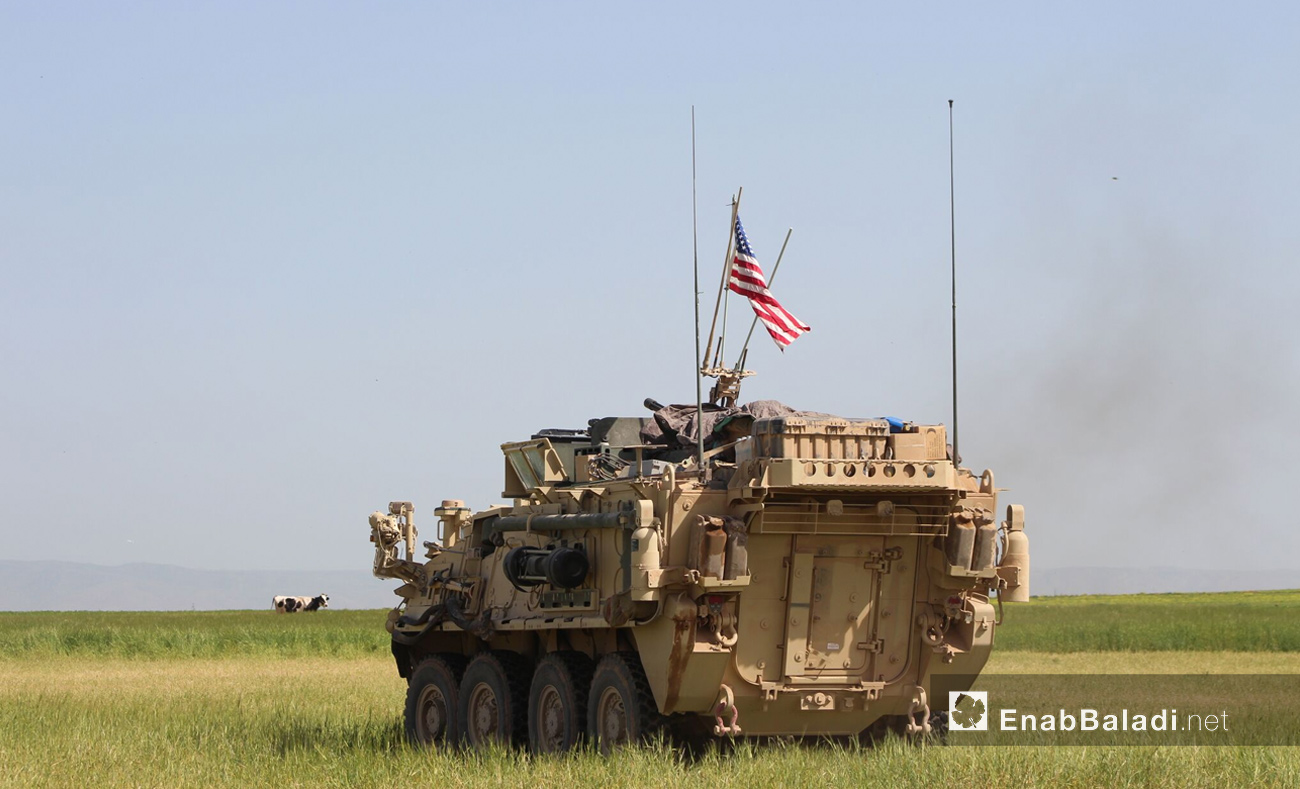
 US tank in the village of al-Ghanama in al-Darbasiyah on the Syrian-Turkish border, 1 May 2017 (Enab Baladi)
US tank in the village of al-Ghanama in al-Darbasiyah on the Syrian-Turkish border, 1 May 2017 (Enab Baladi)





 A
A
A
A
A
A

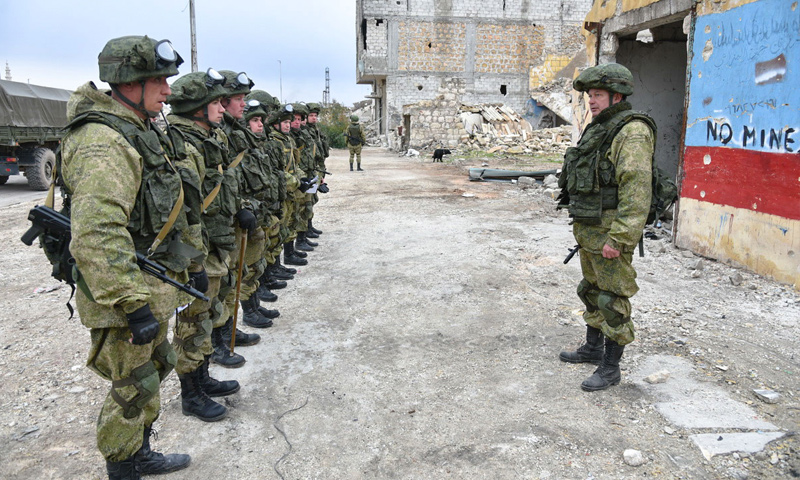
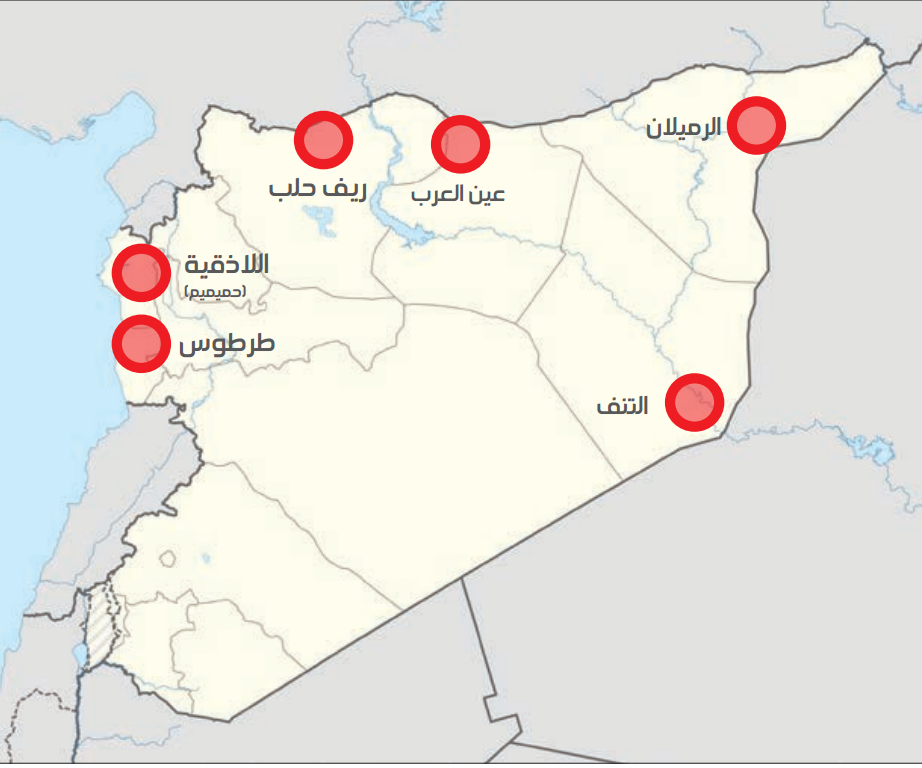


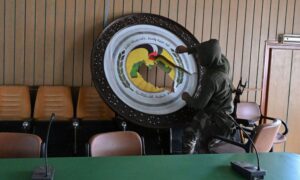
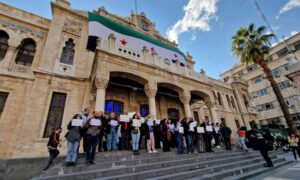
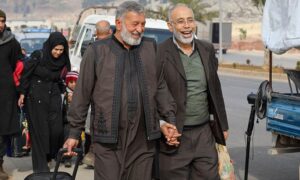
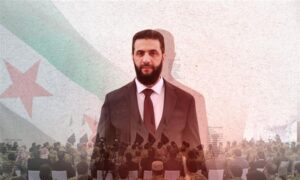
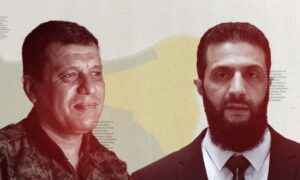
 More In-Depth
More In-Depth